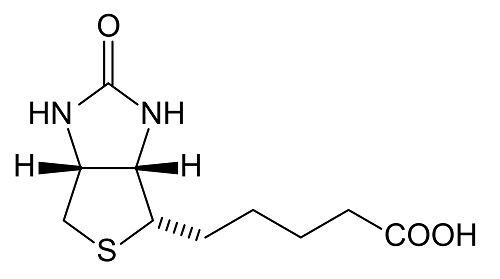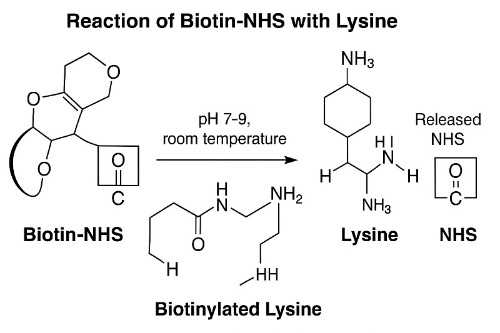Biotinylation: An Overview
Biotinylation, as defined by the American Chemical Society (ACS), is the process of covalently attaching biotin, a small vitamin B7 derivative (MW = 244.31 g/mol), to a protein, nucleic acid, or other molecule. This technique is popular due to its rapidity, specificity, and minimal interference with the natural function of the modified molecule.

Figure 1: Chemical structure of biotin
Biotinylation allows for the precise labeling of biomolecules, making it an invaluable tool in various scientific disciplines. See this Wikipedia article for a comprehensive introduction.
How Does Biotinylation Work?
The magic of biotinylation lies in the extremely high affinity between biotin and proteins like streptavidin and avidin. According to Thermo Fisher Scientific, biotin binds to streptavidin and avidin with a dissociation constant (Kd) of approximately 10⁻¹⁴ mol/L. This strong interaction allows biotinylated molecules to be captured or detected under extreme conditions.

Figure 2: Structural diagram of the reaction between biotin-NHS and lysine
A common method uses biotinylation reagents such as N-hydroxysuccinimide (NHS) esters to target primary amines. Once the molecule is biotinylated, it can be easily captured or detected using streptavidin-coated surfaces or streptavidin-conjugated probes.
What Are the Uses of Biotinylation?
In Research
Biotinylation is essential in molecular biology. Techniques such as affinity chromatography use biotinylated proteins to isolate specific targets. As explained in the Journal of Chromatography A, this method improves purification precision.
Biotinylation is also used in protein–protein interaction studies and pull-down assays, as highlighted in Nature Methods.
In Diagnostics
Biotin-streptavidin technology enhances sensitivity in immunoassays, such as ELISAs. Guidelines from the Clinical and Laboratory Standards Institute (CLSI) confirm the effectiveness of biotinylated antibodies in detecting low-level biomarkers.
In Therapeutics
Biotinylated nanoparticles have shown promise in targeted drug delivery. A study funded by the National Institutes of Health (NIH) used biotinylated liposomes for targeting cancer cells with encouraging preclinical outcomes.
Biotinylation Reagents and Solubility
As noted by Thermo Fisher Scientific, commonly used amine-reactive biotinylation reagents include NHS esters, which require organic solvents like DMSO for solubility. Sulfo-NHS esters, which are water-soluble, are better suited for cell-surface biotinylation where aqueous conditions are needed.
Biotinylation Reagents in Biotin Labeling
The ideal biotinylation reagent depends on the target group and solubility needs. For sulfhydryl groups, maleimide-containing biotin derivatives are preferred. Resources from Sigma-Aldrich outline reagents for thiol-specific reactions.
Cleavable biotinylation reagents also exist, useful for downstream recovery and analysis of the labeled molecules.
Which Industries Use Biotinylation?
Pharmaceutical Industry
The pharmaceutical sector uses biotinylation for monoclonal antibody labeling and drug screening. Pharmaceutical Research has shown how biotin improves antibody-drug conjugate performance.
Biotechnology Startups
Startups often build point-of-care diagnostics using biotin-streptavidin systems. Many are supported by the Small Business Innovation Research (SBIR) program.
Academic Research
Academic labs use biotinylation in cell biology and neuroscience. The Journal of Neuroscience reported using biotinylated dextran amine to trace neural pathways in brain tissue.
New Breakthrough Applications in 2025
Single-Cell Analysis
In 2025, single-cell biotinylation is enabling precise protein mapping. According to Cell, this technique helps study cellular heterogeneity with high spatial resolution.
3D Bioprinting
Biotinylated biomaterials are now used in 3D bioprinting. As shown in Nature Biotechnology, this allows for controlled integration of cells and growth factors into tissue scaffolds.
Conclusion
Advancements in biotinylation technology in 2025 are opening new frontiers in science and industry. Whether you're in research, diagnostics, or therapeutics, leveraging these innovations offers a competitive advantage.
Contact us today to discover how our biotinylation solutions can support your projects.

 +8613708084407
+8613708084407

